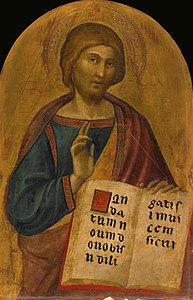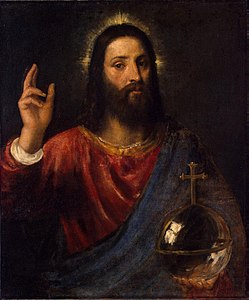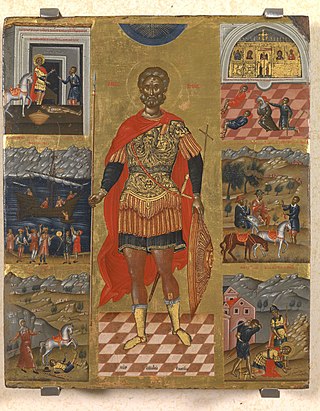
Cretan School describes an important school of icon painting, under the umbrella of post-Byzantine art, which flourished while Crete was under Venetian rule during the Late Middle Ages, reaching its climax after the Fall of Constantinople, becoming the central force in Greek painting during the 15th, 16th and 17th centuries. The Cretan artists developed a particular style of painting under the influence of both Eastern and Western artistic traditions and movements; the most famous product of the school, El Greco, was the most successful of the many artists who tried to build a career in Western Europe, and also the one who left the Byzantine style farthest behind him in his later career.

Emmanuel Tzanes, also known as BounialisEmmanuel Tzane-Bounialis, Emmanuel Zane, and Emmanuel Tzane. He was a Greek Renaissance painter. He was an author, clergyman, painter, and educator. He was the parish priest of the church of San Giorgio dei Greci. An important Greek church in Venice. He was affiliated with the Flanginian School of the Greek Confraternity in Venice. He was a prominent painter. His known works number over 130 pieces. His works can be found in public foundations, private collections, churches and monasteries in Greece. He collaborated with many artists namely Philotheos Skoufos. Both artists were members of the Cretan School. He was influenced by the Venetian school. Emmanuel's brothers were famous painter Konstantinos Tzanes and poet Marinos Tzanes. His most popular work is The Holy Towel finished in 1659.

Andreas Ritzos also known as (Andreas Rico, Ricio or Rizo) was a Greek icon painter from Crete. Ritzos is considered one of the founding fathers of the Cretan School. He was affiliated with Angelos Akotantos. Most of his work stylistically follows the traditional maniera greca. His children, grandchildren, and great-grandchildren were also painters. He was one of the most influential painters of the Cretan School along with Andreas Pavias and Angelos Akotantos. He influenced the works of Georgios Klontzas, Nikolaos Tzafouris, Theophanes the Cretan, Michael Damaskinos and El Greco. According to the Institute for Neohellenic Research, sixty of his paintings have survived.

Ilias or Elias Moskos was a Greek educator, shipping merchant and painter from Crete. The last name Moskos was associated with three famous painters of the Cretan School alive during the same period, along with Ioannis Moskos and Leos Moskos, possibly his relatives. Elias incorporated maniera greca with the Venetian style. Theodore Poulakis and Moskos brought the art and style of Crete into the Heptanese School of the Ionian Islands. Some of his work was inspired by Angelos Akotantos. He was affiliated with other artists such as Philotheos Skoufos. He is often confused with Leos Moskos. His son was not Ioannis Moskos although they were probably related. Elias most popular painting is Christ Pantocrator. Fifty-two of his paintings survived.
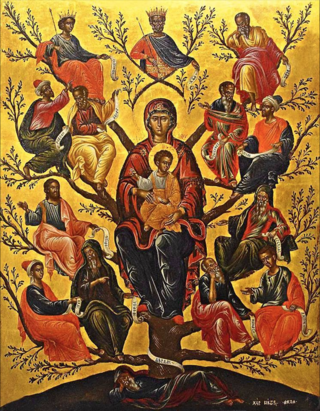
Victor was a painter active during the 17th century. He represented the late Cretan school. He was influenced by Michael Damaskinos. He kept his style simple and followed the lines of the improved maniera greca which was heavily influenced by the Venetian school. One of his main influences was Michael Damaskinos. He was active when four different artists used the name Victor. He has a huge catalog of work attributed to him. According to the Neo-Hellenic Institute, ninety-five of his paintings and one fresco survived. He was an extremely popular Greek icon painter.

Stephanos Tzangarolas also known as Stephano Tzangarola. He was a Greek painter during the late Cretan Renaissance. He migrated from Crete to the island of Corfu. He is a member of the Heptanese School and the Cretan Renaissance. His contemporaries at the time were Panagiotis Doxaras, Theodore Poulakis and Elias Moskos. His artwork began to reflect the transition of the classical maniera greca of Crete to the more refined style of the Ionian Islands. His style resembles the transition of Gentile da Fabriano and Fra Angelico from the maniera greca to their respective styles. Tzangarolas paintings influenced countless artists both Italian and Greek. Some artists that reflect his style include Spyridon Sperantzas and Georgios Kastrofylakas. His paintings can be found all over Greece mainly Athens and the Ionian Islands. Some of his work is in Cairo and London. His student was famous Greek painter Andreas Karantinos.
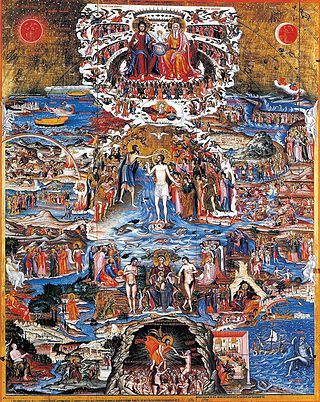
Ioannis Kornaros was a Greek painter. He was one of the few painters from Crete during the 19th century. He does not belong to the Cretan Renaissance but was influenced by the art. He is considered to be one of the foremost icon painters of the Greek Neoclassical era and Modern Greek Enlightenment in art also known as Neo Hellenikos Diafotismos. He implemented a unique style. He was influenced by Michael Damaskinos, Georgios Klontzas, Victor and other Cretan artists. He influenced Modern Greek art. He is one few Greek painters affiliated with Cyprus. Others included Ioannis Kyprios and Theodore Apsevdis. His teacher was Georgios Kastrofylakas. His most famous painting Great Art Thou resembles Georgios Klontzas's In Thee Rejoiceth.

Emmanuel Skordilis, also known as Emmanouil Skordilis. He was a Greek Renaissance painter. He was active in Crete around the time Emmanuel Tzanes, Elias Moskos, and Philotheos Skoufos were painting in Crete. He belongs to the elite group of Greek painters that followed the Venetian influenced maniera greca in Crete. Sixty eight of his works survived. He is one of few artists to not travel to the Ionian Islands and participate in the Heptanese School. He eventually settled in the Cyclades on the inland of Milos. Christodoulos Kalergis is another prominent Greek artist associated with the Cyclades, he was from Mykonos. Skordilis was influenced by Georgios Klontzas, Michael Damaskinos and Angelos. Skordilis brought the artistic style of Crete to the Cyclades and influenced countless artists in that region.

Georgios Kastrofylakas (Greek: Γεώργιος Καστροφύλακας, 1699/1705 – 1760/1770), also known as Georgios Kastrofylax or (Zorzis). He is one of the few Greek painters that remained in Crete. Others included Ioannis Kornaros. Kornaros was his student. Kastrofylakas followed the lines of the Cretan School. His work was influenced by legendary artists such as Georgios Klontzas, Michael Damaskinos and Angelos. Historians argue Kastrofylakas had many students due to the resemblance of his work. He belongs to the Neo-Hellenikos Diafotismos in painting and the Greek Rococo period. He influenced countless Greek iconographers. Thirty-six paintings are attributed to Kastrofylakas. The artist added more realism to his paintings. Most of his artwork is in Heraklion, Crete. His most notable work is the Adoration of the Magi.

Nicholas Ritzos also known as Rizo and Ricio). He was a Greek Renaissance painter. His father was famous painter Andreas Ritzos. His brother was painter Thomas Ritzos. His son was painter Manea Ritzos. Nicholas and his father Andreas Ritzos are the forefathers of the Cretan School of painting. They influenced countless artists both Greek and Italian. There painting style was the typical Venetian influenced maniera greca in Crete. The island transitioned from the classical Byzantine painting to a more refined style. His contemporaries were Andreas Pavias, Nikolaos Tzafouris, and Angelos Akotantos. They influenced painters such as Michael Damaskinos, Petros Lambardos, and Emmanuel Lambardos. Nine of his works have survived.

Ieremias Palladas, also known as PouladasIeremia Pallada. He was a Greek Renaissance painter. He was a clergyman, painter, and educator. He was affiliated with Saint Catherine's Monastery in Mount Sinai, Egypt. He is one of the most notable Greek painters of the 17th century. His family consisted of clergy and painters. His nephew was Patriarch of Alexandria Gerasimos Palladas. His work was influenced by Nikolaos Tzafouris and Angelos Akotantos. Georgios Klontzas and Emmanuel Lambardos were active in Crete around the same period. Palladas influenced the works of Theocharis Silvestros, Iakovos Moskos, Ioannis Kornaros and Philotheos Skoufos. According to the Institute of Neohellenic Research, twenty-four of his works survived. His specialty was painting crosses for the iconostasis or templo. Most of his works are in Egypt.
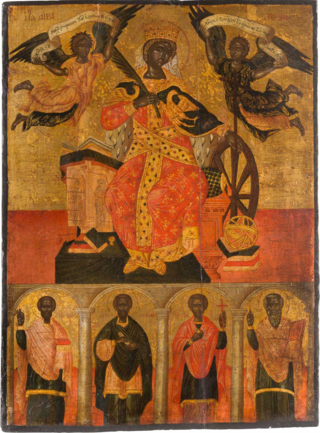
Theocharis Silvestros was a Greek Baroque painter. He was a monk affiliated with Saint Catherine's Monastery Mount Sinai, Egypt. He was also active in Heraklion Crete. He was influenced by famous painters Emmanuel Lambardos and Ieremias Palladas. Theocharis was a renowned painter of the Cretan School. He influenced countless Greek painters. He was active during the same period as Philotheos Skoufos and Franghias Kavertzas. His most notable works are of Catherine of Alexandria. Most of his remaining works are associated with Saint Catherine's Monastery Mount Sinai, Egypt. He was a Sinaitic monk.

Euphrosynos was a Greek Renaissance painter. He was a priest and influenced by Byzantine art and the early Cretan School. Five of his works have survived, all of them are in Greece. His technique resembled the works of Andreas Pavias, Angelos Akotantos, and Andreas Ritzos. Euphrosynos may have been a member of the prominent Klontzas family. His paintings of the Virgin Mary and Jesus are typical Cretan School paintings. His Jesus painting resembles Pavias's painting Christ Pantocrator. All of his works are at Mount Athos in the Dionysiou Monastery. They decorate the iconostasis. Fragkos Katelanos and Theophanes the Cretan were also working at Mount Athos around the same period.

Konstantinos Paleokapas was a Greek painter active during the 17th century. He was active in Crete. His contemporaries were: Elias Moskos, Leos Moskos, Victor (iconographer), Franghias Kavertzas and Ieremias Palladas. His style was similar to his contemporaries, the artists were part of the Cretan School. The art was heavily influenced by Venetian art. His remaining work testifies to the style of the region. Six of his works have survived. His most notable work is the Crucifixion of Christ. His Crucifixion is comparable to the Ioannis Moskos Crucifixion and The Crucifixion (Pavias) by Andreas Pavias. His Crucifixion lacks the unique Impenitent thief found in many followers of Pavias's style. His Crucifixion mostly resembles Ioannis Moskos. Paleokapas had a unique style. Most of his work is at the Gonia Monastery in Crete.

Georgios Nomikos was a Greek painter. He converted to Christianity from Judaism. He was a Greek Baroque painter. He was a member of the Cretan School and the Heptanese School. His contemporaries were Georgios Kastrofylakas, Theodore Poulakis, and Georgios Markou. He shared the same last name with famous Greek painter Demetrios Nomikos. He was active on the island of Zakynthos, Kefalonia Arta and Ioannina. Six of his paintings survived. Some of his frescos have survived in the destroyed church of Saint George in Lingiades, Ioannina. His work represents an evolution from the art of Angelos Akotantos and Elias Moskos to a more refined technique influenced by the art of the Ionion Islands.

Georgios Kortezas, also known as Tzortzis Kourtezas. He was a Greek baroque painter. He was a member of the Cretan School. He was from a wealthy family. Notable Greek painters active during the same period were Georgilas Maroulis, Ieremias Palladas and Theocharis Silvestros. His style was the Venetian influenced Greek mannerism with some Byzantine influence characteristic of Cretan art. Three of his works survived. The Tragedy of Saint Demetrios. The painting is at the Benaki Museum. The Archangels Gabriel, Micheal, and Raphael. Poli Museum, Corfu. Finally, George Slaying the Dragon is part of the Provatorov Collection in Geneva.

Saint Catherine is a tempera painting created by Ieremias Palladas. Palladas was a Greek painter from Crete. He was a Sinaitic monk. He was associated with Saint Catherine's sacred monastery in Egypt also known as Mount Sinai. The monastery is at the location where Mosses received his tablets. There was a dependency of the monastery in Heraklion, Crete by the same name. Palladas completed works for the monastery in Egypt. He also created works for the Holy Sepulture in Jerusalem and a church in Bethlehem, Israel. His version of the martyr became the framework of Cretan paintings of Saint Catherine. Another Sinaitic monk named Theocharis Silvestros worked with Palladas. He also created notable versions of Saint Catherine around the same period.

The Crucifixion is a tempera painting by Konstantinos Paleokapas. Paleokapas was a Greek painter from the island of Crete. He was active during the early part of the 1600s. Six of his works survived, four are signed. The Crucifixion is one of the most popular events in human history. The scene has been duplicated countless times. Many crucifixion paintings were created by painters from the island of Crete. Some painters included El Greco, Andreas Pavias, Georgios Markazinis and Ioannis Moskos. Paleokapas created his own version of the popular subject. His crucifixion painting followed the prototype of many other paintings thematically. He added both the dice players and the resurrection of the dead. Andreas Pavias’s The Crucifixion (Pavias) and Margkazinis’s The Crucifixion (Margkazinis) both feature the popular pictorial representation of Mathews gospel. Paleokapas’s Crucifixion is located at the Gonia Monastery in Crete.

Catherine of Alexandria is a tempera painting created by Ieremias Palladas. Palladas was a monk associated with Saint Catherine's sacred monastery in Egypt also known as Mount Sinai. He was a painter and teacher. His nephew became the Patriarch of Alexandria. His name was Gerasimos Palladas. Ieremias was a Sinaitic monk because of his association with Saint Catherine's monastery on Mount Sinai. The monastery encloses the site where it is assumed by Christians that Moses saw the burning bush. Ieremias was one of the most influential figures of his time. The Patriarch of Jerusalem Nectarius wrote about the painter in his archives.

Transfiguration and Monastic Scenes is a multi-themed tempera painting created by Greek painter Georgios Klontzas. Klontzas was a Cretan Renaissance painter. The artist was hired to assess work completed by El Greco. Klontzas was from a wealthy family and owned a successful workshop in the center of Crete. His existing catalog consists of Fifty-four works. He completed incredible triptychs and manuscripts. Klontzas and Micheal Damaskinos are two of the most prominent Greek painters of the 16th century due to the size of their catalogs and the popularity of their works excluding El Greco.


